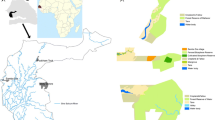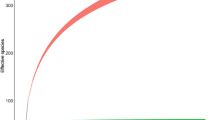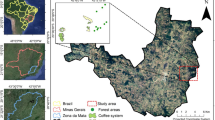Abstract
Forest restoration is carried out with varying objectives in mind, one of which is biodiversity conservation. The present study examines the extent by which tree biodiversity could potentially be maximized in the context of the pan-African Great Green Wall for the Sahara and the Sahel Initiative (GGW). Towards this end, ten indigenous tree species were selected for study in the Ferlo region in Northern Senegal based on previous ethnobotanical studies in the zone. The species included Acacia senegal, Acacia nilotica, Acacia tortilis subsp. raddiana, Acacia seyal, Adansonia digitata, Balanites aegyptiaca, Dalbergia melanoxylon, Sclerocarya birrea, Tamarindus indica and Ziziphus mauritiana. Germination experiments were first performed in the laboratory on seed lots from Senegal, Burkina Faso, Kenya, and South Africa prior to in situ sapling production in the nursery in Northern Senegal situated along the GGW. A split plot field design was employed and the effects of seed provenance (two per species) and the addition of organic fertilizer at the timing of planting were determined. Over the course of the 2 year experimental period, the newly planted trees, in addition to the naturally regenerating woody vegetation and herbaceous grasses were monitored in the fenced-in experimental field plot. Of the ten species, only B. aegyptiaca, A. tortilis subsp. raddiana, and S. birrea exhibited moderate survival rates. The effects of provenance and fertilizer addition were sporadic and species-dependent. Natural regeneration of woody species was abundant albeit characterized by low biodiversity whereas herbaceous grass species showed extensive biodiversity, especially under tree canopies as compared to open areas.







Similar content being viewed by others
References
African Union and Pan African GGW Agency (2010) Harmonised regional strategy for implementation of the “Great Green Wall Initiative of the Sahara and the Sahel”. http://www.greatgreenwallinitiative.org/sites/default/files/publications/harmonized_strategy_GGWSSI-EN_.pdf. Accessed 22 Dec 2016
Akpo LE, Grouzis M (1996) Influence du couvert ligneux sur la régénération de quelques espèces ligneuses sahéliennes (Nord-Sénégal, Afrique occidentale). Webbia 50:247–263
Arbonnier M (2002) Arbres, arbustes et lianes des zones sèches de l’Afrique de l’Ouest. CIRAD – MNHN. Pony-sur-Yonne, France
Aubreville A (1949) Climats, forêts et désertification de l’Afrique tropicale. Société d’éditions géographiques, maritimes et coloniales, Paris, France
Barral H, Bénéfice K, Boudet G et al (1983) Les systèmes de production d’élevage au Sénégal dans la région du Ferlo: synthèse de fin d’études d’une équipe de recherches pluridisciplinaire. ORSTOM, Paris
Barrett CB, Constas MA (2014) Toward a theory of resilience for international development applications. Proc Natl Acad Sci USA 111:14625–14630. https://doi.org/10.1073/pnas.1320880111
Boshier D, Broadhurst L, Cornelius J, Gallo L, Koskela J, Loo J, Petrokofsky G, St Clair B (2015) Is local best? Examining the evidence for local adaptation in trees and its scale. Environ Evid 4:20. https://doi.org/10.1186/s13750-015-0046-3
Brandt M, Mbow C, Diouf AA, Verger A, Samimi C, Fensholt R (2015) Ground- and satellite-based evidence of the biophysical mechanisms behind the greening Sahel. Glob Chang Biol 21:1610–1620. https://doi.org/10.1111/gcb.12807
Breman H, Kessler JJ (1995) Woody plants in agro-ecosystems of semi-arid regions with an emphasis on Sahelian countries. Springer, Berlin
Ciccarese L, Mattsson A, Pettenella D (2012) Ecosystem services from forest restoration: thinking ahead. New Forest 43:543–560. https://doi.org/10.1007/s11056-012-9350-8
Davies J, Poulsen L, Schulte-Herbrüggen B, Mackinnon K, Crawhall N, Henwood WD, Dudley N, Smith J, Gudka M (2012) Conserving dryland biodiversity. International Union for Conservation of Nature, Gland
Davies J, Robinson LW, Ericksen PJ (2015) Development process resilience and sustainable development: insights from the drylands of Eastern Africa. Soc Nat Resour 28:328–343. https://doi.org/10.1080/08941920.2014.970734
De Leeuw J, Njenga M, Wagner B, Iiyama M (2014) Treesilience: an assessment of the resilience provided by trees in the drylands of Eastern Africa. ICRAF, Nairobi
Diallo A, Agbangba EC, Ndiaye O, Guissé A (2013) Ecological structure and prediction equations for estimating tree age, and dendometric parameters of Acacia senegal in the Senegalese semi-arid zone-Ferlo. Am J Plant Sci 4:1046–1053
Guissé A, Boëtsch G, Ducourneau A, Goffner D, Gueye L (2013) L’observatoire homme–milieux international Tessékére (Ohmi): un outil de recherche pour étudier la complexité des écosystèmes arides du Sahel. C R Biol 336:273–277
Herrmann SM, Tappan GG (2013) Vegetation impoverishment despite greening: a case study from central Senegal. J Arid Environ 90:55–66. https://doi.org/10.1016/j.jaridenv.2012.10.020
ICSU, ISSC (2015) Review of the sustainable development goals: the science perspective. International Council for Science (ICSU), Paris
Jacobs DF, Oliet JA, Aronson J, Bolte A, Bullock JM, Donoso PJ, Landhäusser SM, Madsen P, Peng S, Rey-Benayas JM, Weber JC (2015) Restoring forests: what constitutes success in the twenty-first century? New Forest 46:601–614
Kherief SN, Nouasria D, Salemkour N, Benchouk K, Delhamra M (2013) La mise en repos: une technique de gestion des parcours steppiques. Journal Algérien des Régions Arides, Numéro Spécial 12:115–123
Le Houérou HN (1989) La variabilité de la pluviosité annuelle dans quelques régions arides du monde; ses conséquences écologiques. In: Bret B (ed) Les hommes face aux sécheresses IHEAL editions. IHEAL, Paris, pp 127–137
Lebrun JP, Stork AL (1991–2015) Enumération des plantes à fleurs d’Afrique tropicale et tropical african flowering plants: ecology and distribution, vol. 1–7. Conservatoire et jardin botaniques de la ville de Genève, Geneva, Switzerland
Leprun JC (1971) Nouvelles observations sur les formations dunaires sableuses fixées du Ferlo nord occidental (Sénégal). ASEQUA 31:69–78
Mbow C, Brandt M, Ouedraogo I, De Leeuw J, Marshall M (2015) What four decades of earth observation tell us about land degradation in the Sahel? Remote Sens 7:4048–4067. https://doi.org/10.3390/rs70404048
MEA, Millennium Ecosystem Assessment (2005) Ecosystems and human well-being: desertification synthesis. World Resources Institute, Washington DC
Miehe S, Kluge J, Wehrden H, Retzer V (2010) Long-term degradation of Sahelian rangeland detected by 27 years of field study in Senegal. J Appl Ecol 47:692–700
Ndiaye O, Diallo A, Sagna MB, Guissé A (2013) Diversité floristique des peuplements ligneux du Ferlo, Sénégal. VertigO, vol 13, no 3
Niang K, Sagna MB, Ndiaye O, Thiaw A, Diallo A, Akpo LE, Saleh MM, Diome N, Diatta S, Faye MN, Gueye M, Guissé A, Goffner D (2014) Revisiting tree species availability and usage in the Ferlo region of Senegal: a rationale for indigenous tree planting strategies in the context of the Great Green Wall of the Sahara and Sahel Initiative. J Exp Biol Agric Sci 2:529–537
Orwa C, Mutua A, Kindt R, Jamnadass R, Anthony S (2009) Agroforestree database: a tree reference and selection guide version 4.0. World Agroforestry Centre, Kenya
Ozer P, Hountondji Y-C, Niang AJ, Karimoune S, Manzo OL, Salmon M (2010) Désertification au Sahel: historique et perspectives. Bulletin de la Société Géographique de Liège 54:69–84
Poupon H (1980) Structure et dynamique de la strate ligneuse d’une steppe sahélienne au nord du Sénégal. ORSTOM, Paris
Radwan UAA (2007) Photosynthetic and leaf anatomical characteristics of the drought-resistant Balanites aegyptiaca (L.) Del. seedlings. Am Eurasian J Agric Environ Sci 2:680–688
Reij C, Winterbottom R (2015) Scaling up regreening: six steps to success. A practical approach to forest and landscape restoration. World Resources Institute technical report. http://www.wri.org/sites/default/files/scaling-regreening-six-steps-success.pdf. Accessed 11 Nov 2016
Reij C, Tappan G, Smale M (2009) Agroenvironmental transformation in the Sahel: another kind of “Green Revolution.” IFPRI Discussion Paper. International Food Policy Research Institute, Washington, D.C.
Rockström J, Steffen WL, Noone K et al (2009) A safe operating space for humanity. Nature 461:472–475. https://doi.org/10.1038/461472a
Roe D (2010) Linking biodiversity conservation and poverty alleviation: a state of knowledge review. CBD Technical Series no 55. https://www.cbd.int/doc/publications/cbd-ts-55-en.pdf. Accessed 23 Jan 2017
Roussel J (1995) Pépinières et plantations forestières en Afrique tropicale sèche: manuel à l’usage des ingénieurs et techniciens du reboisement. ISRA, Dakar
Sackville Hamilton NR (2011) Is local provenance important in habitat creation? A reply. J Appl Ecol 38:1374–1376
Sendzimir J, Reij CP, Magnuszewski P (2011) Rebuilding resilience in the Sahel: regreening in the Maradi and Zinder, regions of Niger. Ecol Soc 16:1. https://doi.org/10.5751/ES-04198-160301
Sinare H, Gordon LJ, Enfors Kautsky E (2016) Assessment of ecosystem services and benefits in village landscapes—a case study from Burkina Faso. Ecosyst Serv 21:141–152
Sy O (2003) Dynamique des ressources en eau et évolution de la mobilité pastorale en zone sylvopastorale. Dissertation, Université Cheikh Anta Diop, Dakar, Senegal
Tbib A, Chaieb M (2004) La mise en défens des parcours en zones arides: avantages écologiques et obstacles socio-économiques. Cahiers Options Méditerranéennes 62:473–476
UNCCD (1994) United Nations Convention to Combat Desertification in those countries experiencing serious drought and/or desertification, Particularly in Africa. UNEP-London. http://www2.unccd.int. Accessed 12 Nov 2016
Venter SM, Witkowski ETF (2013) Where are the young baobabs? Factors affecting regeneration of Adansonia digitata L. in a communally managed region of southern Africa. J Arid Environ 92:1–13. https://doi.org/10.1016/j.jaridenv.2012.12.010
Verte GM (2009) Choix des Espèces végétales et des Systèmes de Mise en valeur et de Suivi. http://www.doc-developpement-durable.org/file/ArbresFruitiers/FICHES_ARBRES/jujubier/ChoixEspecesPourGrandeMurailleVerte.pdf. Accessed 21 Feb 2017
Weston P, Hong R, Kaboré C, Kull CA (2015) Farmer-managed natural regeneration enhances rural livelihoods in dryland West Africa. Environ Manag 55:1402–1417. https://doi.org/10.1007/s00267-015-0469-1
Wezel A, Lykke AM (2006) Woody vegetation change in Sahelian West Africa: evidence from local knowledge. Environ Dev Sustain 8:553–567. https://doi.org/10.1007/s10668-006-9055-2
Zida D, Tigabu M, Sawadogo L, Oden PC (2008) Initial seedling morphological characteristics and field performance of two Sudanian savanna species in relation to nursery production period and watering regimes. Forest Ecol Manag 255:2151–2162
Acknowledgements
The authors sincerely thank the Senegalese National Great Green Wall Agency for technical and logistical assistance. A warm thanks goes to Mbacké Fall and villagers for invaluable help in the nursery at Widou Thiengoly. We also thank Arnaud Ouedraogo who helped us to localize some of the “out-of-the-way” places in Burkina Faso from which our seeds came from. We thank Seyni Sané for help in statistical analyses. We thank Karine Ginoux and Sophie Drame who always insure that our field missions runs as smoothly as possible from an administrative standpoint. The authors acknowledge Institut Klorane and Fondation Véolia Environnement for financial support and a Ph.D. fellowship for T. I. Wade and to Labex DRIIHM (ANR-11-LABX-0010) (Laboratoire d’Excellence Dispositif de Recherche Interdisciplinaire sur les Interactions Hommes-Milieux) for M. Mauclaire’s PhD fellowship. We thank the CNRS Observatoire Hommes-Milieux Tessékéré (OHMi) and the Agence Nationale de la Recherche (French National Research Agency) (project Future Sahel – ANR-15-CE03-0001) for funding this research. Finally, we acknowledge the anonymous reviewers for their comments that have allowed us to improve the manuscript.
Author information
Authors and Affiliations
Corresponding author
Electronic supplementary material
Below is the link to the electronic supplementary material.
Rights and permissions
About this article
Cite this article
Wade, T.I., Ndiaye, O., Mauclaire, M. et al. Biodiversity field trials to inform reforestation and natural resource management strategies along the African Great Green Wall in Senegal. New Forests 49, 341–362 (2018). https://doi.org/10.1007/s11056-017-9623-3
Received:
Accepted:
Published:
Issue Date:
DOI: https://doi.org/10.1007/s11056-017-9623-3




